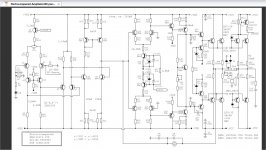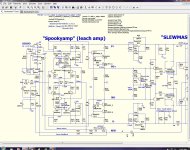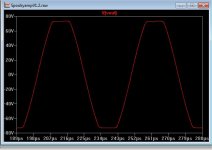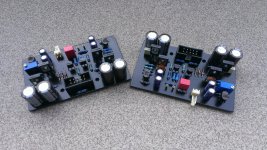I've been waiting for this front-end to progress a little more. I've never played with tubes. Looking forward to trying it out.Hi All,
Another contribution to front-ends collection. Still a little bit under construction - no prototype yet. This is a revised version of my initial hybrid. I was working on it, mostly focusing on keeping the balance during start-up, when OS inspired me by super-pair VAS. So, this is what I came up with in the end.
THD20 is not measurable by Multisim even at 40V RMS output swing, low TIM by design, nice clipping. Much better behavior at start-up, thanks to a-la-Sansui symmetric mirrored LTP approach.
This is the next one I will prototype - working on PCB...
Comments are welcome 😉
Cheers,
Valery
One of the {different} implementations of a op-amp V to I converter .
(below 1).
U2 is a unity gain follower ... and a current sink. R8 and 7 are
the current feedback loop. U1 is a current sinking inverting servo.
I've gotten crazy good operation at <5ppm using some op-amp
models and some ringing with other models.
Since this is a true current FB/IC "abomination" , slew is stellar ...
and compensation is easy (C6 and 5).
Only a couple Arcam IPS's have a similar circuit (prior art).
Any opinions are welcome. An IC based amp would be a nice
addition to the "lineup" 😀 .
OS
Now we have a Slewmaster chip amp! Valery's doing tubes. I'm waiting to see what other kinds of incarnations this amplifier has in store. All we need now is some right angle male and female headers to fit the boards so we can swap front ends as fast as they are coming out.
Last edited:
Any comment on the post #4302 please.
Thank you
It looks like it would work, if you want to use it then it's worth a try. Although I worry about the BC139/140 because every manufacturer has their own idea of what that transistor should be like, some are worse than others.
Hi
I would like to post a simple driver stage..
In case bad idea please feel free to delete from the forum.
I do think these would be worth to be give some taught or to be tested.
Greetings
Yes ! That is a variant of the Cordell hybrid triple.
Search the " trouble with triples" DIYA thread. This was my intro (learning)
stage to get the slewmaster Locanthi output stage correct.
I was tempted to use Cordell's OP , with thermal cancellation of the first
2 stages.
I opted to be safe, and instead used my Harmon kardon 680 OP .. as
I had the real thing to use as a reference.
Cordell's diamond based triple actually does slew a tad bit faster with
>500V+/uS IPS's ... but the standard fare (slewmaster) is quite adequate.
OS
Now we have a Slewmaster chip amp! Valery's doing tubes. I'm waiting to see what other kinds of incarnations this amplifier has in store. All we need now is some right angle male and female headers to fit the boards so we can swap front ends as fast as they are coming out.
Not quite yet !
While not critically buggy , it still does not simulate to perfection.
Being dependent on some suckers design at the "chiphouse" , a wide
variation in both performance and relative stability is noted.
Perhaps someone with more insight on IC based amp's could help
me. 😱
OS
Hi All,
Another contribution to front-ends collection. Still a little bit under construction - no prototype yet. This is a revised version of my initial hybrid. I was working on it, mostly focusing on keeping the balance during start-up, when OS inspired me by super-pair VAS. So, this is what I came up with in the end.
THD20 is not measurable by Multisim even at 40V RMS output swing, low TIM by design, nice clipping. Much better behavior at start-up, thanks to a-la-Sansui symmetric mirrored LTP approach.
This is the next one I will prototype - working on PCB...
Comments are welcome 😉
Cheers,
Valery
More inspiration .... 😀
Looks like the Scandinavian "ampliwire " topology (below)
minus the tubes and
the current sourcing of the second stages.
PS - I note your VAS design ... using the Baxandall as the cascode reference.
Quite a hybrid ! Would this be a true "super Hawksford" ??
Attachments
Last edited:
Just wanted to say welcome back OS and Thimios. Nice to see both of you back on the thread. Have a nice Sunday.
Thanks my friend.Just wanted to say welcome back OS and Thimios. Nice to see both of you back on the thread. Have a nice Sunday.
I'm happy shown all us together again🙂
"Tubasui" VAS + spookyamp = ???
What I was looking for .... 🙂
(below 1/2)
faster slew , less load on the input cascodes ,
and .... that cool clip ! (below 3)
Spasiba ... Mr. V !
OS
What I was looking for .... 🙂
(below 1/2)
faster slew , less load on the input cascodes ,
and .... that cool clip ! (below 3)
Spasiba ... Mr. V !
OS
Attachments
OS,
Right about the time you had to leave the thread to go on your journey there was some modifications made to the CFA-XH and was referred to as the CFA-XH BV version. I think it kind of stopped waiting on you OS to make comments on any other improvements that could be made and whether it had been a worthwhile improvement. Could someone re-post the relevant schematics so OS can make some comments?
ps. I think we ended up with 2 or 3 versions of the BV modifications.
Right about the time you had to leave the thread to go on your journey there was some modifications made to the CFA-XH and was referred to as the CFA-XH BV version. I think it kind of stopped waiting on you OS to make comments on any other improvements that could be made and whether it had been a worthwhile improvement. Could someone re-post the relevant schematics so OS can make some comments?
ps. I think we ended up with 2 or 3 versions of the BV modifications.
Waiting some pcb for startWhat I was looking for .... 🙂
(below 1/2)
faster slew , less load on the input cascodes ,
and .... that cool clip ! (below 3)
Spasiba ... Mr. V !
OS

What I was looking for .... 🙂
(below 1/2)
faster slew , less load on the input cascodes ,
and .... that cool clip ! (below 3)
Spasiba ... Mr. V !
OS
Very cool!

Also, worth trying BC5XX as a first transistor in the pair - THD may go even lower 😉 They are just excellent at low Vcb...
OS,
Right about the time you had to leave the thread to go on your journey there was some modifications made to the CFA-XH and was referred to as the CFA-XH BV version. I think it kind of stopped waiting on you OS to make comments on any other improvements that could be made and whether it had been a worthwhile improvement. Could someone re-post the relevant schematics so OS can make some comments?
ps. I think we ended up with 2 or 3 versions of the BV modifications.
The last mod variant was one by OS. I tried building it but couldn't get it to work. Maybe now that OS is back we can revisit it. When I get to my computer I will re-post the schematic.
OS,
Right about the time you had to leave the thread to go on your journey there was some modifications made to the CFA-XH and was referred to as the CFA-XH BV version. I think it kind of stopped waiting on you OS to make comments on any other improvements that could be made and whether it had been a worthwhile improvement. Could someone re-post the relevant schematics so OS can make some comments?
ps. I think we ended up with 2 or 3 versions of the BV modifications.
Biggest issue with the NAD/CFA-X was the excessive current demands on the
stages feeding the VAS ... especially during an overload condition.
CFA... "current on demand" could supply this current , but the devices could
be brought close to max Ic , as well.
With the "super Hawksford", Vas Ib is in the uA range (below) .... preceding
stages are " unaware" of any abuse (clipping).
There was one good BV mod (looping comp. back to first IP stage).
Combine this new VAS with that mod = perfection !!
OS
Attachments
More inspiration .... 😀
Looks like the Scandinavian "ampliwire " topology (below)
minus the tubes and
the current sourcing of the second stages.
PS - I note your VAS design ... using the Baxandall as the cascode reference.
Quite a hybrid ! Would this be a true "super Hawksford" ??
I'm pretty much familiar with Electrocompaniet topology, however in my case interface between first tube LTP and second pair of LTPs is very important - it needs to be as balanced as possible even when anode voltages go up and down (simultaneously)...
"Super Hawksford" - came out as a rather cool, combined "building block". I started, just adding a normal Hawksford to a super-pair, then I just saw I can arrange the same reference for level shifter (LED), tying it to the "first" emitter, rather than the "second" one. Also saving one resistor 🙂 Seems to be stable enough, with all the benefits of super-pair and cascoded VAS. This is where Mr. Baxandall and Mr. Hawksford met each other 😉
I'm pretty much familiar with Electrocompaniet topology, however in my case interface between first tube LTP and second pair of LTPs is very important - it needs to be as balanced as possible even when anode voltages go up and down (simultaneously)...
"Super Hawksford" - came out as a rather cool, combined "building block". I started, just adding a normal Hawksford to a super-pair, then I just saw I can arrange the same reference for level shifter (LED), tying it to the "first" emitter, rather than the "second" one. Also saving one resistor 🙂 Seems to be stable enough, with all the benefits of super-pair and cascoded VAS. This is where Mr. Baxandall and Mr. Hawksford met each other 😉
I was frustrated ... my first attempt was an oscillator (1mhz+).
Much !! more stable with a low Vce first Baxandall device AND the
main cascode base-stoppers. 🙂
I am sure we really have quite the VAS here ... all my IPS's
are in single digit PPM territory with no loading - perfect clip .... using
this "abomination" 😀 .
OS
Well, normal thing - in many cases, at first power on, oscillators never start, amplifiers - oscillate 😀 

Well, normal thing - in many cases, at first power on, oscillators never start, amplifiers - oscillate 😀
http://www.diyaudio.com/forums/solid-state/164093-100w-ultimate-fidelity-amplifier-2.html post #16 🙂
Yes ! That is a variant of the Cordell hybrid triple.
Search the " trouble with triples" DIYA thread. This was my intro (learning)
stage to get the slewmaster Locanthi output stage correct.
I was tempted to use Cordell's OP , with thermal cancellation of the first
2 stages.
I opted to be safe, and instead used my Harmon kardon 680 OP .. as
I had the real thing to use as a reference.
Cordell's diamond based triple actually does slew a tad bit faster with
>500V+/uS IPS's ... but the standard fare (slewmaster) is quite adequate.
OS
Thank you ostripper
I read it through, good to learn ne thinks.🙂
These OP was built on a Hungarian DIY forum and get very good feedback how she perform.
It has a layout on that site if someone interested.
I will test these after I built the SlewMoster or one of the variation.🙂
Yes some BD139 & 140 sound awful other are better, I do not like them.
Some people still prefer them 🙄 at lower voltage. Example DX.
Greetings gabor
Attachments
Last edited:
- Home
- Amplifiers
- Solid State
- Slewmaster - CFA vs. VFA "Rumble"





